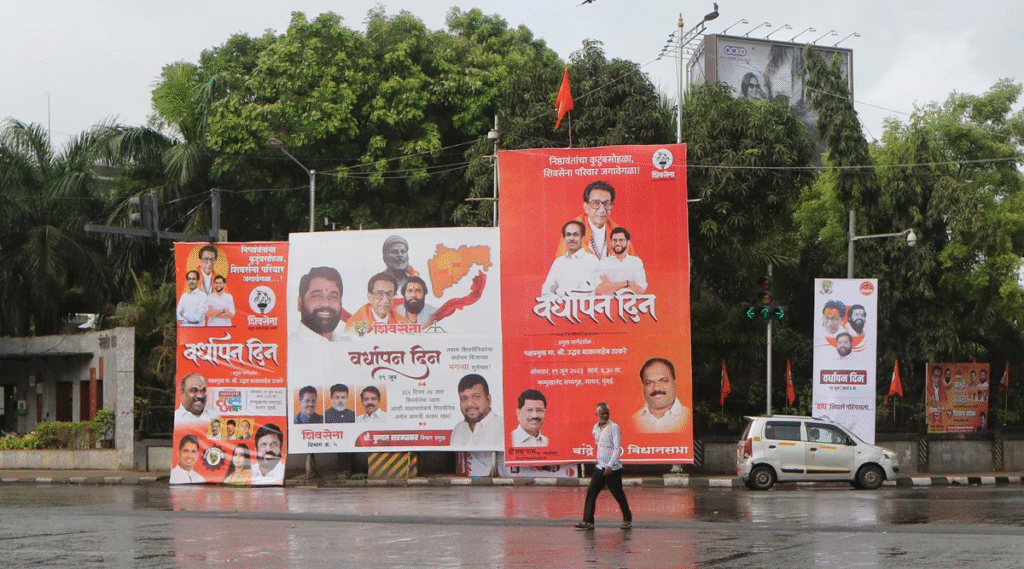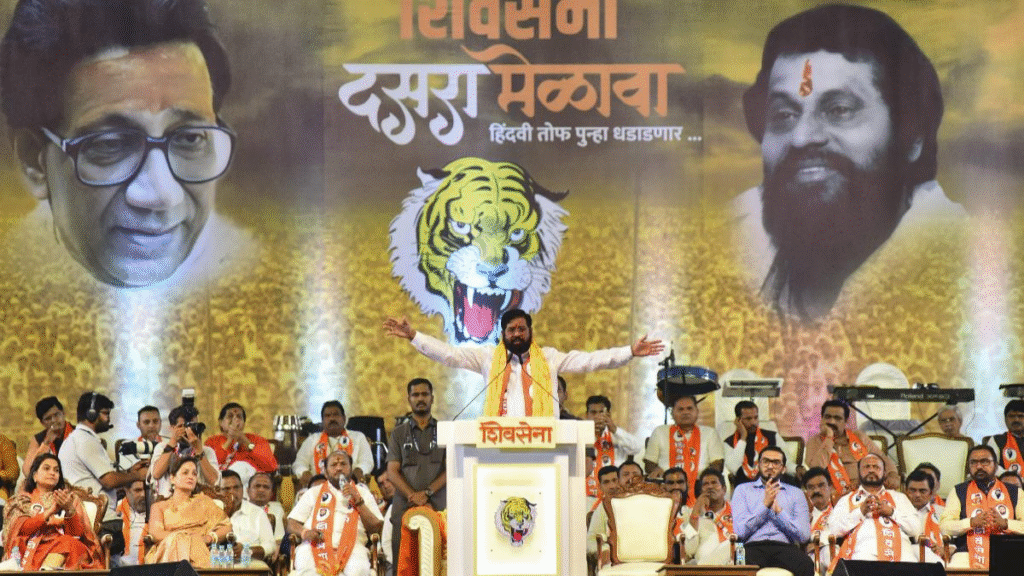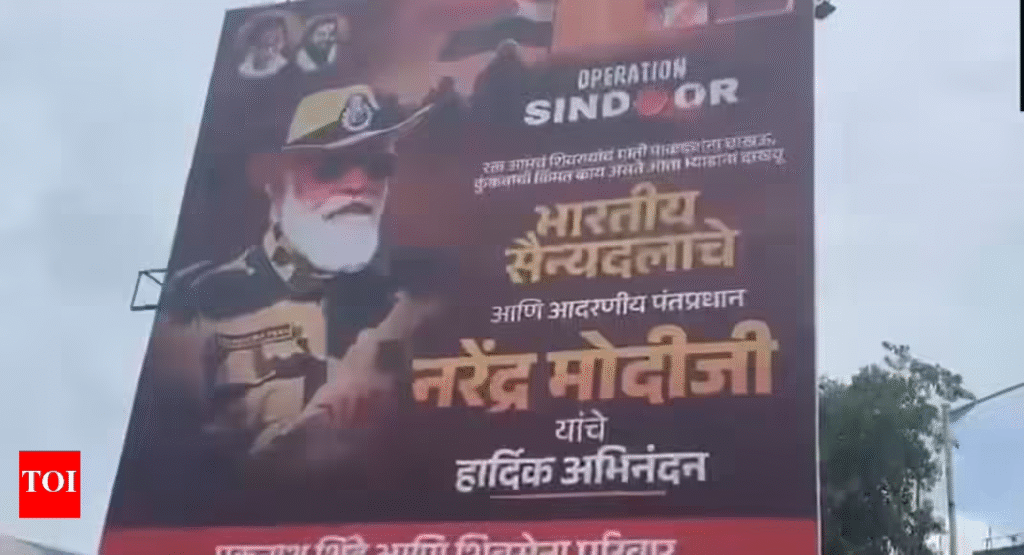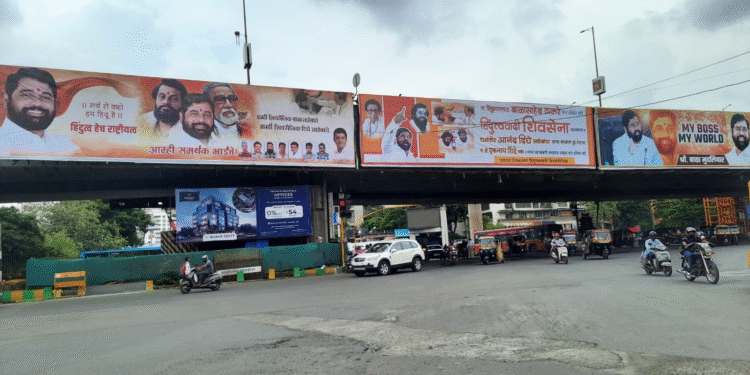Is the Shinde Sena subtly taking aim at its ally BJP with its new posters in Mumbai’s BKC? As local body polls near, the political messaging reveals deeper tensions beneath the surface
In the high‑stakes lead-up to the Mumbai local body elections, political messaging has turned bold. Among the deployment of banners and hoardings across the metropolis, one set of posters in Bandra Kurla Complex (BKC) has drawn attention—not just for visibility, but for tone. While on the surface it promotes Shinde Sena’s identity and resilience, observers wonder if there is a subtle—or not so subtle—message aimed at the BJP, its alliance partner.
As electoral contests intensify, symbolic communication becomes a frontline in intra‑alliance competition. The BKC posters may be more than promotional—they may signal discontent, ambition, or strategic leverage. Below is a deep dive into what these posters suggest, how they fit into the alliance dynamics, what political messaging they carry, and what this means for local politics in Mumbai.
Background: Shinde Sena, BJP, and the Mumbai Context

The Shinde Breakaway & Alliance Structure
After the split in Shiv Sena, the faction led by Eknath Shinde aligned with the Bharatiya Janata Party (BJP) under a coalition (Mahayuti) in Maharashtra. The new configuration positioned the Shinde Sena as a junior ally but with ambition of influence in key local bodies like BMC, Thane, and others.
In Mumbai specifically, Shinde Sena has been jockeying for relevance and visibility. The party has held rallies in BKC, made membership drives, and sought to assert itself as the “real Shiv Sena” inheritor.
Municipal Ambitions & Seat Sharing
Ahead of the forthcoming BMC elections, the Mahayuti alliance’s internal contours are under strain. The BJP, which has substantial strength and cadre in Mumbai, is vying for control over mayoral, deputy mayoral posts, and key wards. Shinde Sena, with former Uddhav Sena corporators joining its fold, claims it can contest independently and demand favorable seat allocations.
Shinde Sena also reportedly seeks quid pro quo: supporting BJP in Mumbai in exchange for BJP backing Shinde’s influence in Thane and Kalyan-Dombivli civic bodies.
Given that backdrop, any public messaging by Shinde Sena must be interpreted not just as outreach to voters but as internal communication to the BJP and its own cadres.
The Poster in BKC: Message, Design & Placement
Visual & Textual Elements
From media reports and local watchers, the BKC poster in question features Shinde Sena’s imagery (party leaders, saffron motifs, homage to Bal Thackeray) and election calls (e.g. “Sena in every home,” “Ghar Tithe Sena,” or emphasizing 365-day presence).
But more pointedly, some banner versions carry taglines like “Yanda Mayor Shivsena Chach” (This time the Mayor will be from Shiv Sena) — a line that directly challenges BJP’s claim on mayoral posts under the Mahayuti banner.
The placement—BKC, a high-visibility business and financial hub—ensures that both public and political eyes see it.
Inference: Behind the Messaging
At first glance, the poster asserts Shinde Sena’s loyalty to legacy and ideology (Bal Thackeray, party identity) and readiness for civic duties. On a deeper level, the “Mayor from Shiv Sena” line signals to BJP that Shinde doesn’t accept a subordinate role in municipal power sharing.
It’s a statement of claim, not merely branding. In alliance politics, such symbolic claims often signal pressure for negotiation or a warning: “Do not marginalize us.”
Is the Target the BJP?

Subtext Over Overt Conflict
The poster does not explicitly name BJP or attack it. But in the context of alliance tensions, that is often the preferred strategy—veiled messaging rather than direct confrontation. Political communication literature suggests that intra-alliance signalling is typically coded to maintain public unity while broadcasting demands internally.
Here, the “Mayor from Sena” message is a soft challenge: if BJP wants Shinde’s support in Mumbai (or elsewhere), it must concede mayoral influence to the Sena. In other words, Shinde Sena is preemptively staking claim to bargaining power before seat-sharing discussions.
Precedents & Alliances Cracks
Similar messaging tactics have appeared before. In Nanded, posters emerged against the Shinde-led faction that read “50 khoke, 105 doke” (referring to legislative numbers) — BJP officially denied involvement, but the episode exposed subtle intra‑coalition messaging.
In Mumbai, the Express covered how Shinde Sena and BJP have engaged in a “poster war,” appropriating Bal Thackeray’s imagery to assert legitimacy, provoking calls from Thackeray’s UBT faction.
So the BKC poster may belong to this continuing pattern—asserting autonomy and reminding BJP that Shinde Sena has political weight.
Political Dynamics & Strategic Risks

Why Shinde Sena is Doing This Now
- Strengthening Electoral Identity
With the local bodies polls nearing, Shinde Sena wants voters to recognize it as a standalone brand, not just “BJP ally.” The poster reinforces that identity. - Negotiating Leverage
By making public claims, Sena sends signals to BJP that it demands greater share in municipal bargaining (mayor, ward tickets, administrative access). - Mobilizing Cadres
Posters rally the party’s workers, validating their role and injecting a sense of assertiveness ahead of campaign season. - Countering UBT Narratives
Uddhav Thackeray’s faction has been attacking the BJP for “fake Hindutva” and criticizing the Mahayuti alliance. Shinde Sena must respond by showing it holds ground.
The Downside: Friction & Backlash
- Alienating Alliance Partners
The BJP may view overt claims as insubordination. If mismanaged, it can disrupt alliance cohesion or lead BJP to retaliate in seat allocations. - Voter Confusion
Ambiguous messaging (strong Sena claims under BJP umbrella) might confuse voters: is the Sena independent or part of the alliance? Mixed signals can dilute voter loyalty. - Aggressive Counter Messaging
Opponents (UBT Sena, Congress) could use the poster as proof of alliance instability, sowing doubt about Shinde Sena’s sincerity. - Legal / Civic Clean-Up Action
Mumbai’s civic authorities regularly remove illegal banners. If the posters are unapproved or violate norms, BMC actions could escalate into political skirmishes.
Local Repercussions: Mumbai & BMC Terrain
Mayoral Race Claim
The “Mayor from Sena” line is particularly striking. It directly contests BJP’s expected claim to that position. This indicates Sena’s confidence or belief that its electoral footprint has grown enough to vindicate mayoral power.
In urban politics, mayoral control matters—not just symbolic, but operational (urban policy, resource allocation, civic contracts). Sena wants to imply it should share or lead in governance, not function as a junior partner.
Seat-Sharing & Ward Distribution
Shinde Sena’s public claim pressures BJP to concede more wards or prime wards to Sena. Often in civic polls, the battle is in lucrative or high-vote wards. Public claims may shift negotiating baseline.
Reports suggest Shinde Sena has already poached around 45 corporators formerly with UBT in Mumbai, giving it a base to contest more wards.
Also, the alliance talks reportedly include cross-pacts: BJP dominates Mumbai, Sena seeks dominance in Thane & Kalyan-Dombivli.
Voter Perception & Branding
Shinde Sena wants to be seen as a party that delivers balanced identity (Marathi, Hindu nationalism, welfare). Posters reinforcing legacy symbols (Bal Thackeray) help consolidate core vote banks while making electoral claims.
What to Watch: Upcoming Moves & Signals
- Counter-posters & Reactions
Does BJP respond with its own posters? Do they assert “Mayor will be BJP” or mock Sena’s ambition? The poster war may intensify. - Seat-Sharing Agreements
The agreements formalized between BJP and Sena will reveal whether the posters were bluff or serious demands. - Ward-level Allocations
Tracking which areas Sena contests independently or takes the lead in will confirm the implications of the publicity. - Civic Authority Response
If posters are removed or replaced by civic action, that could spark public debate on fairness and political targeting. - Messaging from Opponents
UBT Sena, Congress, MNS may use this as leverage to question coalition stability and woo voters seeking alternatives. - Public Discourse & Media Commentary
Editorials, cable TV debates, and civic activists will unpack this symbolism and either amplify or undercut the poster’s intent.
Sample Structure for a Local News Post
Headline: Is Shinde Sena’s BKC Poster a Message to BJP? Strain in Alliance as BMC Polls Near
Lead (first paragraph): A new billboard in Mumbai’s BKC by Shinde Sena has stirred speculation. At face value, the poster celebrates party identity and resolve—but the embedded claim “Yanda Mayor Shivsena Chach” reveals a deeper strategic nudge to BJP: stake your share.
Body:
- Context: history of Sena split, alliance, local bodies politics
- Poster analysis: visuals, lines, placement
- Alliance tension: past disputes, bargaining
- Repercussions: for seat talks, public perception
- Expert / analyst quotes (you’d insert local observers)
- What happens next: signals to watch, possible moves
Conclusion:
The BKC poster is more than a promotional hoarding—it is a calibrated political instrument. It signals that Shinde Sena wants to ensure it is not lost in the shadow of BJP, demands bargaining respect, and aims to project itself as a stake-holder, not a sidekick. The real test will be how the BJP responds—by accommodating, resisting, or counterattacking.















 Categories
Categories









